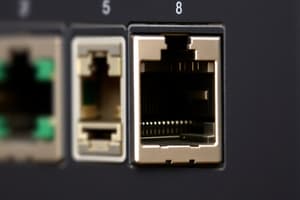Podcast
Questions and Answers
What is the maximum value of a byte in decimal format?
What is the maximum value of a byte in decimal format?
- 256
- 128
- 512
- 255 (correct)
Which class of IP addresses is reserved for experimental purposes?
Which class of IP addresses is reserved for experimental purposes?
- Class E (correct)
- Class D
- Class C
- Class B
What portion of an IP address does the Network ID define?
What portion of an IP address does the Network ID define?
- Only the first byte
- The entire IP address
- The part of the address that identifies the network (correct)
- The specific host within the network
In a Class A IP address, how many bytes are allocated for the Host ID?
In a Class A IP address, how many bytes are allocated for the Host ID?
Which binary prefix denotes a Class D IP address?
Which binary prefix denotes a Class D IP address?
What is the primary function of a MAC address?
What is the primary function of a MAC address?
Which layer of the OSI model does a MAC address operate at?
Which layer of the OSI model does a MAC address operate at?
What distinguishes an IP address from a MAC address?
What distinguishes an IP address from a MAC address?
How is an IPv4 address structured?
How is an IPv4 address structured?
Why is it not advisable to use any IP address in a network that is not currently connected to the Internet?
Why is it not advisable to use any IP address in a network that is not currently connected to the Internet?
What is the bit length of an IPv4 address?
What is the bit length of an IPv4 address?
Which of the following IP address ranges is designated for private use in Class C?
Which of the following IP address ranges is designated for private use in Class C?
Which of the following is true regarding IPv6 addresses?
Which of the following is true regarding IPv6 addresses?
What is the purpose of a logical address in a networking context?
What is the purpose of a logical address in a networking context?
What does the loopback address 127.0.0.1 refer to?
What does the loopback address 127.0.0.1 refer to?
In classful addressing, how many networks are available in Class A private address space?
In classful addressing, how many networks are available in Class A private address space?
Which of the following describes a characteristic of a MAC address?
Which of the following describes a characteristic of a MAC address?
What does a direct broadcast address signify?
What does a direct broadcast address signify?
Which of the following is a key benefit of subnetting a given network?
Which of the following is a key benefit of subnetting a given network?
What is the purpose of IANA reserving certain IP address ranges?
What is the purpose of IANA reserving certain IP address ranges?
If given a network address of 150.100.0.0 /16, how can you divide it into three separate networks?
If given a network address of 150.100.0.0 /16, how can you divide it into three separate networks?
What is the required subnet prefix length for an organization needing 4 subnets from the block 130.34.12.64/26?
What is the required subnet prefix length for an organization needing 4 subnets from the block 130.34.12.64/26?
How many addresses are available in the block starting at 14.24.74.0/24?
How many addresses are available in the block starting at 14.24.74.0/24?
What distinguishes Variable Length Subnet Masking (VLSM) from Class-full routing?
What distinguishes Variable Length Subnet Masking (VLSM) from Class-full routing?
What is the benefit of using Classless routing over Class-full routing?
What is the benefit of using Classless routing over Class-full routing?
If an organization requires 2 subnets with 64 addresses each, what subnet prefix should be used?
If an organization requires 2 subnets with 64 addresses each, what subnet prefix should be used?
Why would an organization use VLSM?
Why would an organization use VLSM?
What is the formula to calculate the number of addresses available based on the prefix length?
What is the formula to calculate the number of addresses available based on the prefix length?
In the given address block, how many 4-address subnets can be created from 14.24.74.0/24?
In the given address block, how many 4-address subnets can be created from 14.24.74.0/24?
What are the three parts into which an IP address is divided?
What are the three parts into which an IP address is divided?
What does the subnet mask '255.255.192.0' represent in binary?
What does the subnet mask '255.255.192.0' represent in binary?
Which of the following addresses would be classified as Subnet 1?
Which of the following addresses would be classified as Subnet 1?
How is classless addressing indicated for IP addresses?
How is classless addressing indicated for IP addresses?
What characterizes the most significant bits allocated in subnetting?
What characterizes the most significant bits allocated in subnetting?
Which of the following correctly describes 150.100.64.1?
Which of the following correctly describes 150.100.64.1?
How many subnets can be created with a /18 subnet mask from a /16 network?
How many subnets can be created with a /18 subnet mask from a /16 network?
What is the host address range for Subnet 1 (150.100.64.0 /18)?
What is the host address range for Subnet 1 (150.100.64.0 /18)?
Study Notes
TCP/IP Addressing
- Addressing in TCP/IP involves three types: Physical, Logical, and Port addresses.
- MAC Address is the physical address, set by the manufacturer, 48 bits in length, typically written in hexadecimal format.
- IP Address serves as the logical address, necessary for identifying devices on a network.
Physical Addresses
- Stored in Network Interface Cards (NIC), fixed and unchangeable.
- MAC addresses follow the Data Link Layer standard and are essential for Ethernet networking.
Logical Addresses
- IP Addresses exemplify logical addressing, extensively used with the TCP/IP protocol.
- Two IP versions exist:
- IPv4 uses a 32-bit addressing scheme (e.g., 192.168.16.53).
- IPv6 employs a 128-bit addressing scheme.
IP Version 4 (IPv4)
- Composed of four octets (bytes), each byte ranging from 0 to 255.
- The minimum IPv4 address is 0.0.0.0, and the maximum is 255.255.255.255.
Network ID and Host ID
- An IP address comprises Network ID plus Host ID.
- Class A (1 byte Net ID, 3 bytes Host ID), Class B (2 bytes Net ID, 2 bytes Host ID), Class C (3 bytes Net ID, 1 byte Host ID).
IPv4 Address Classes
- Class D is designated for multicasting, while Class E is reserved for experimental purposes.
- Private IP address ranges include:
- Class A: 10.0.0.0
- Class B: 172.16.0.0 to 172.31.0.0
- Class C: 192.168.0.0 to 192.168.255.0
Special IP Addresses
- Network Address: Designates the entire network, all host bits are 0.
- Direct Broadcast Address: Targets all hosts within a specific network, all host bits are 1.
- Loopback Address: Standard loopback address is 127.0.0.1 for testing.
Classful Addressing
- Traditional addressing method where each class has a fixed size subnet mask.
Subnetting and Classless Addressing
- Subnetting divides a single network into multiple subnets, enhancing efficiency.
- Classless Addressing uses CIDR (Classless Inter-Domain Routing) and specifies variable-length subnet masking.
- Example: For network 150.100.0.0/16, subnetting can create multiple subnets using bits from the host portion for subnetting.
Variable Length Subnet Masking (VLSM)
- Allows different subnets within the same network to have varying subnet masks.
- More efficient for organizations with unequal device counts in different subnets.
Example of Subnetting
- Block 130.34.12.64/26 can be subdivided into multiple smaller subnets using VLSM.
The Need for Multiple Subnets
- An organization can require different subnet sizes for specific needs. For instance:
- 2 subnets with 64 addresses
- 3 subnets with 16 addresses
- Total subnets can exceed original class capacity through effective subnetting strategy.
Summary
- Understanding TCP/IP addressing is crucial for network configuration and management.
- Differentiation between MAC (physical) and IP (logical) addresses is essential.
- IPv4 remains a widely utilized version while transitioning to IPv6 is underway.
- Subnetting techniques like VLSM improve address efficiency and network flexibility.
Studying That Suits You
Use AI to generate personalized quizzes and flashcards to suit your learning preferences.
Related Documents
Description
This quiz covers Lecture 2 of IT2050 on Computer Networks, focusing on IP Addressing. It delves into different types of addresses including physical, logical, and port addressing, essential for understanding TCP/IP protocols.




